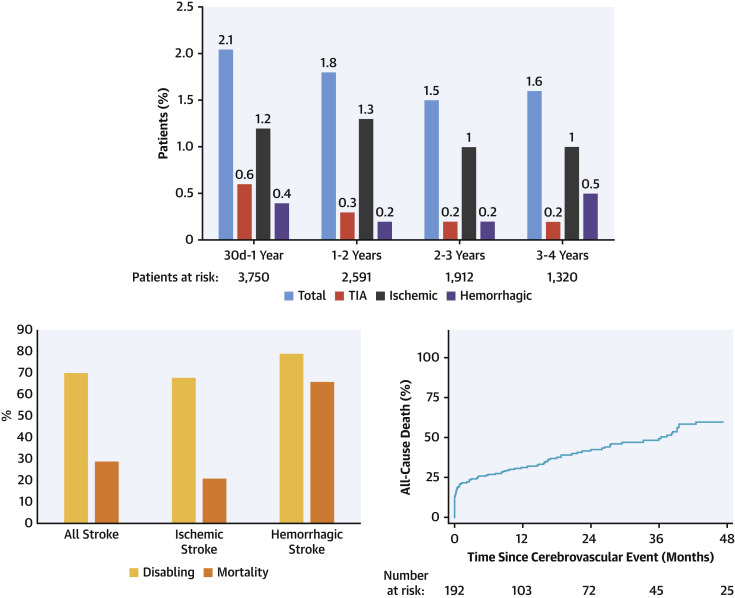JACC: Cardiovascular Interventions ( IF 11.7 ) Pub Date : 2020-03-11 , DOI: 10.1016/j.jcin.2019.11.022 Guillem Muntané-Carol , Marina Urena , Antonio Munoz-Garcia , Remigio Padrón , Enrique Gutiérrez , Ander Regueiro , Vicenç Serra , Giulianna Capretti , Dominique Himbert , Cesar Moris , Manel Sabaté , Bruno Garcia del Blanco , Alfredo Nunes Ferreira-Neto , Mélanie Coté , Quentin Fischer , Thomas Couture , Dimitri Kalavrouziotis , Josep Rodés-Cabau

|
Objectives
This study sought to determine the incidence, clinical characteristics, associated factors, and outcomes of late cerebrovascular events (LCVEs) (>30 days post-procedure) following transcatheter aortic valve replacement (TAVR).
Background
Scarce data exist on LCVEs following TAVR.
Methods
This was a multicenter study including 3,750 consecutive patients (mean age, 80 ± 8 years; 50.5% of women) who underwent TAVR and survived beyond 30 days. LCVEs were defined according to VARC-2 criteria.
Results
LCVEs occurred in 192 (5.1%) patients (stroke, 80.2%; transient ischemic attack, 19.8%) after a median follow-up of 2 (1 to 4) years. Late stroke was of ischemic, hemorrhagic, and undetermined origin in 80.5%, 18.8%, and 0.7% of patients, respectively. Older age, previous cerebrovascular disease, higher mean aortic gradient at baseline, the occurrence of stroke during the periprocedural TAVR period, and the lack of anticoagulation (novel oral anticoagulants or vitamin K antagonists) post-TAVR were independent factors associated with late ischemic stroke/transient ischemic attack (p < 0.05 for all). Echocardiographic data at the time of the LCVE showed no signs of valve thrombosis or degeneration in the vast majority (97%) patients. Late stroke was disabling in 107 (69.5%) patients (ischemic, 68%; hemorrhagic, 79%), and associated with an in-hospital mortality rate of 29.2%.
Conclusions
LCVEs occurred in 5.1% of TAVR recipients after a median follow-up of 2 years. LCVEs were ischemic in most cases, with older age, previous cerebrovascular events, higher mean aortic gradient at baseline, the occurrence during the periprocedural TAVR period, and lack of anticoagulation (but not valve thrombosis/degeneration) determining an increased risk. Late stroke was disabling in most cases and associated with dreadful early and midterm outcomes.
中文翻译:

经导管主动脉瓣置换术后晚期脑血管事件
目标
这项研究试图确定经导管主动脉瓣置换术(TAVR)后晚脑血管事件(LCVE)(手术后> 30天)的发生率,临床特征,相关因素和结局。
背景
TAVR之后,LCVE上缺少数据。
方法
这是一项多中心研究,纳入了3,750名接受TAVR且存活超过30天的连续患者(平均年龄80±8岁;女性占50.5%)。LCVE是根据VARC-2标准定义的。
结果
在中位随访2年(1-4年)后,有192例(5.1%)患者发生了LCVE(中风,占80.2%;短暂性脑缺血发作,占19.8%)。晚期卒中分别为缺血性,出血性和不确定来源,分别占80.5%,18.8%和0.7%的患者。老年,缺血性脑卒中,基线时平均主动脉梯度升高,术中TAVR期间中风的发生以及TAVR后缺乏抗凝药(新型口服抗凝药或维生素K拮抗剂)是与缺血性卒中晚期/短暂性脑缺血发作(全部p <0.05)。LCVE时的超声心动图数据显示,绝大多数(97%)患者没有瓣膜血栓形成或变性的迹象。107名(69.5%)患者中有晚期卒中致残(缺血性,68%;出血性,79%),
结论
中位随访2年后,有5.1%的TAVR接受者发生了LCVE。LCVEs在大多数情况下是缺血性的,年龄较大,以前的脑血管事件,基线时的平均主动脉斜率较高,术中TAVR期间的发生以及缺乏抗凝作用(但无瓣膜血栓形成/变性)决定了增加的风险。在大多数情况下,中风是致残的,并伴有可怕的早期和中期结果。











































 京公网安备 11010802027423号
京公网安备 11010802027423号